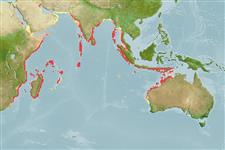Common names from other countries
>
Tetraodontiformes (Puffers and filefishes) >
Balistidae (Triggerfishes)
Etymology: Melichthys: Greek, melas, melaina, melan, black + icthys yos, fish. On the other hand, in Smith et al.,1986: 878), 'body dark brown to black' in https://www.biodiversitylibrary.org/item/266635#page/902/mode/1up.(P. Romero, pers.comm. 03/2022)..
More on authors: Randall & Klausewitz.
Environment: milieu / climate zone / depth range / distribution range
Ecologia
marino associati a barriera corallina; distribuzione batimetrica 1 - 30 m (Ref. 9710). Tropical
Indian Ocean: Red Sea and East Africa eastward to western Thailand and Indonesia.
Size / Peso / Age
Maturity: Lm ? range ? - ? cm
Max length : 25.0 cm TL maschio/sesso non determinato; (Ref. 4420)
Short description
Chiavi di identificazione | Morfologia | Morfometria
Spine dorsali (totale) : 3; Raggi dorsali molli (totale) : 30 - 35; Spine anali: 0; Raggi anali molli: 27 - 30. Narrow white margin round caudal fin; live specimens bluish or violet (Ref. 4420).
Inhabits coral-rich seaward reef slopes (Ref. 9710, 48637). Occurs singly (Ref. 9710). Digs holes below coral bases for shelter (Ref. 48637). Feeds on sponges, algae, crustaceans and small invertebrates (Ref. 5503). Caught with artisanal gear (Ref. 30573). Minimum depth from Ref. 58018.
Life cycle and mating behavior
Maturities | Riproduzione | Spawnings | Egg(s) | Fecundities | Larve
Oviparous, distinct pairing during breeding (Ref. 205).
Smith, M.M. and P.C. Heemstra, 1986. Balistidae. p. 876-882. In M.M. Smith and P.C. Heemstra (eds.) Smiths' sea fishes. Springer-Verlag, Berlin. (Ref. 4420)
IUCN Red List Status (Ref. 130435)
CITES (Ref. 128078)
Not Evaluated
Threat to humans
Harmless
Human uses
Pesca: commerciale; Acquario: Commerciale
Strumenti
Special reports
Download XML
Fonti Internet
Estimates based on models
Preferred temperature (Ref.
115969): 25.4 - 29.3, mean 28.2 (based on 947 cells).
Phylogenetic diversity index (Ref.
82804): PD
50 = 0.6250 [Uniqueness, from 0.5 = low to 2.0 = high].
Bayesian length-weight: a=0.02570 (0.01232 - 0.05364), b=2.94 (2.77 - 3.11), in cm Total Length, based on LWR estimates for this (Sub)family-body shape (Ref.
93245).
Trophic level (Ref.
69278): 3.0 ±0.29 se; based on food items.
Resilienza (Ref.
120179): Alto, tempo minimo di raddoppiamento della popolazione meno di 15 mesi (Preliminary K or Fecundity.).
Fishing Vulnerability (Ref.
59153): Low vulnerability (15 of 100).
